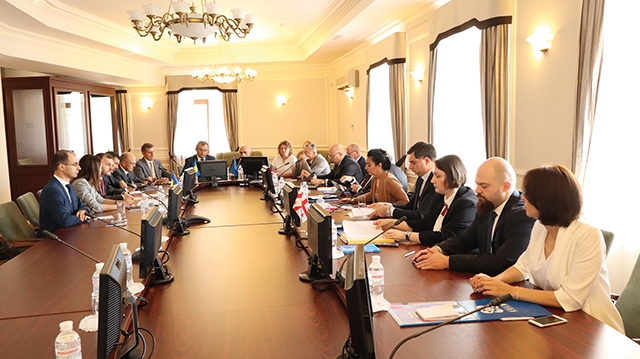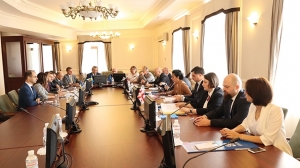Prospects for GUAM’s Development
In December 2019, the Heads of Governments of GUAM (an organization for democracy and economic development) with member states Georgia, Ukraine, Azerbaijan and Moldova, held a multilateral meeting in Kiev.
During the talks, the prime ministers of Ukraine, Georgia and Moldova, Oleksiy Honcharuk, Giorgi Gakharia, Ion Chicu, as well as the Vice PM of Azerbaijan, Ali Akhmedov, discussed issues pertaining to the increase of regional cooperation. According to the joint statement, the countries agreed to expand cooperation with their partner countries and international organizations to carry out regional projects and multilateral programs of economic cooperation. More specifically, the member states expressed the need to use blockchain technologies in verifying certificates of origin for goods’ that are transported across the GUAM Member States, and ensured their mutual recognition of Authorized Economic Operators, the agreement being signed between the customs administrations of each country.
Ukraine’s PM Honcharuk stated that “two documents have been signed; these are protocols of intentions in relation to the functioning of customs agencies in our countries. Enacting these two documents by our customs agencies will significantly simplify trade between us”.
In the same vein, the Former Georgian Prime Minister Mamuka Bakhtadze stated during a summit in 2018: “It is crucial to fully utilize the potential of the GUAM free trade zone and to increase our efforts aimed at enhancing the competitiveness of the GUAM transport corridor,” while in December 2019, Georgian Prime Minister Giorgi Gakharia stated that “territorial integrity is the main challenge facing Azerbaijan, Georgia, Moldova and Ukraine.”
While economic integration has been a backbone of GUAM, its members have significantly shifted their attention towards geopolitical stability and regional threats, which have direct implications on regional economic development and prop up corruption and instability in the region.
The latest gathering might be a turning point for GUAM (initially called GUUAM). Established in 1997 following the collapse of the Soviet Union, small states near the Black Sea attempted to shape a vibrant economic cooperation to lessen dependence on Russia. It also served as one of the first regional models that institutionally linked the Black and Caspian seas, and had an integration role. At one point, even Uzbekistan was a member, which potentially allowed the GUUAM (abbreviation of the participant states: Georgia, Ukraine, Uzbekistan, Azerbaijan, and Moldova) to extend to the heart of Central Asia.
This happened at a time when Russia experienced economic troubles and military insurgency at home, the West was powerful, and various visions were being propounded, including the reinvigoration of ancient silk roads.
Had it worked effectively, the group might have turned into a powerful geopolitical player. For example, Ukraine controls most of the Northern Black Sea and Azerbaijan plays a powerful role as the starting point of a vital trade and a resources’ corridor. In between them is the Georgian bridge. Further afield, through Azerbaijan, it would have been possible to reach out to the Central Asian region, although Uzbekistan pulled out.
The GUAM Alliance, though short of establishing a veritable alliance, without any vacillations, nevertheless shares one common objective: limiting Moscow’s geopolitical influence by enabling the arrangement and export of their own resources to world markets, circumventing Russian territory. In the late 1990s and early 2000s, the project failed to turn into a serious economic body. Russian influence gradually regained its lost positions and quite naturally the countries were unwilling to cause Moscow’s further anger. Moreover, GUUAM, later GUAM, members were also dependent on Russian economic, military and, generally, political benevolence.
Back then, unabashed Russia played well to prevent major western-led projects that could bypass its territory and pull gas and oil from the South Caucasus and Central Asia. Uzbekistan withdrew from the project in 2005 and Azerbaijan, Georgia, Ukraine, and Moldova, with all their economic, internal politics and military weaknesses, were unable to keep up the prospects of GUAM. Distrust towards Russia was not enough to coordinate a well-oiled foreign policy that would eliminate any obstacles towards regional economic growth and integration.
The Russians, quite rightly, fear that such an initially loosened up economic project, including GUAM’s bumpy road, could eventually evolve into a consolidated regional block.
As the recent summit in Kiev revealed, the GUAM initiative might still be weak, but it is far from dead. Perhaps transatlantic, foreign support could be a defining moment. Over the last decade, the EU and US have been more focused on confronting Russia’s moves across the Eurasian landmass; faced with these circumstances, GUAM might be a good basis for creating an interregional economic space guided by principles of western economic and political values.
This year marks the 23rd anniversary of GUAM’s existence, and it could be argued that many geopolitical developments in the Black Sea region point to a coalescing of interests among Georgia, Moldova, Ukraine and Azerbaijan. Primarily among those interests is economic cooperation. A great number of infrastructure projects have been carried out that could enable these countries to establish stronger contacts. Another incentive is the fact that all GUAM member states share complicated relations with Russia.
Emil Avdaliani is a non-resident fellow at GeoCase (Twitter handle - @emilavdaliani)
By Emil Avdaliani, Peter M. Tase











